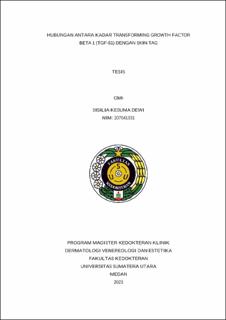Hubungan Antara Kadar Transforming Growth Factor BETA 1 (TGF-ß1) dengan Skin Tag

Date
2023Author
Dewi, Sisilia Kesuma
Advisor(s)
Putra, Imam Budi
Jusuf, Nelva Karmila
Metadata
Show full item recordAbstract
Background: Skin tag, also known as acrochordons, are benign neoplasms that look like a protrusion skin growth. Multifactorial causes of skin tags such as aging, obesity, metabolic and hormonal disorders. One of the mechanisms for the occurrence of skin tags is preceeded by repeated scratching or friction trauma and continuously triggers an inflammatory response. During inflammation, TGF-ß1 is activated to inhibit the adhesion of neutrophils and T cells to endothelial cells, then limiting the recruitment of inflammatory cells. In addition, TGF-β1 is the main promoter in fibroblast proliferation and collagen synthesis as a response to cell repair.
Objectives: To determine the correlation between TGF-ß1 levels and skin tags.
Subjects and Methods: This research was an observational study with a cross-sectional design of 39 skin tag patients and 40 non-skin tag. Each patient underwent history, dermatological examination, and followed by blood sampling to assess TGF-ß1 levels using the ELISA test. These data were analyzed statistically with the Mann-Whitney analytic test.
Results: The mean TGF-β1 level on skin tags was 549.05 ng/mL (SD = 173.52 ng/mL). Most subjects with skin tags had 1–5 lesions, were 24 people (61,5%). The most common type of skin tag was the pedunculated in 9 people (23,1%), followed by the drop form in 6 people (15,3%) and the spherical in 6 people (15,3%). The majority shows that 16 people (41%) have more than 1 type of skin tag in one region. The results of this study revealed that there was a relationship between TGF-β1 low levels and skin tags.
Conclusion: There was a significant relationship between TGF-β1 levels and skin tags (p = 0.013).
